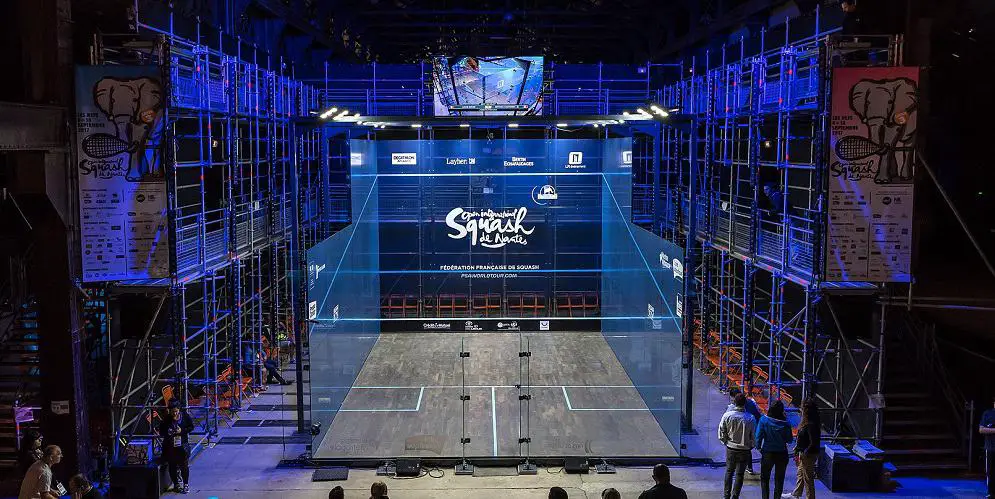Looking to improve your squash game as a beginner? Read on.
The various angles involved in hitting the shots, the confusion between what is a Let Ball and what qualifies to be a stroke, the different kinds of balls that can be used and so on can make the game of squash appear to be a lot more complex than what it actually is.
Having spent a fair bit of time on the squash court improving our skills, there are a few simple tips that we can share to help you de-clutter your mind and improve your game.
Hope you can apply these during your practice sessions and matches.
Table of Content
Spend Some Time Watching Matches
A lot of the squash learning can be latent. Watching matches between professional players is one of the ways to do this.
It is but obvious, that a first time viewer may get overwhelmed by the quality of squash on display by these players.
However, once you are done being flabbergasted by the never ending rallies, cross-court nicks and precise hits along the side wall, you will start picking up the small things that may be useful to you.
The split step, movements around the court, the effective and timely utilization of the boast, patterns of play etc. are few such examples.
PSASquash is an excellent YouTube account to follow to get your dose of high quality professional squash matches.
Play Against as Many Partners As You Can
Playing against the same individuals repeatedly can breed a sense of complacency.
Facing different opponents can expose you to new ways in which to approach a match, or even hitting a particular ball. Some players have a proclivity to play the boast shot, while some are more prone to play cross court shots.
This unpredictability associated with playing new opponents can add further dimensions to your game.
Retrieve Every Ball
If you keep returning as many balls as you can, very soon you will see the frustration that seeps into the opponent. In the effort to hit shots out of your reach, they may take risks which they would have normally avoided and end up making unforced errors.
The joy that one experiences after returning a seemingly un-retrievable shot and the extra calories burnt in the process are other obvious advantages.
Also Read:
3 Games Just for Improving – 2 for Competition
Go with a game plan and try to execute those even if they are not working out. Do not fret if you end up losing a few matches in the bargain.
Suppose you play five games every session, during three of them aim to work on certain pre-decided aspects of your game – without worrying about the match result.
While in the last two games you can try to go for the win to keep that competitive spirit alive.
Play Longer Rallies
This is a corollary to the previous point. The longer the rallies, the more chances you give yourself of developing your game.
Use Visualization Techniques
Most elite sportsmen resort to ‘Visualization’ to help prepare for their competition. A number of Olympic sportsmen are known to have it as an essential part of their training routine.
Someone who followed the Australian cricket team in the first decade after 2000 would have seen how the record breaking batsman Matthew Hayden used to undertake visualization.
Sitting on the cricket pitch before the match the legendary batsman would imagine facing up to the various deliveries that the opposition would bowl to him, and how he would face them.
For those who do not know what that is – visualization requires the individual to be in a relaxed state of mind, and imagine the game play.
Right from imagining about the spot you want the ball to hit when you serve, to the way in which you want to rotate your body to play a backhand down the line, everything and anything related to the match can be visualized.
Imagine hitting a lob into the back corner when you have been dragged to the front of the court by a drop shot by your opponent.
This ensures that your sub-conscious mind gets used to such situations – so that you are not caught unaware during a match.
In fact, not just sportsmen, visualization is an essential part of training even for pilots.
Avoid Cross Courts as Much as Possible
Considering the difficulty associated with hitting a return straight along the wall, a number of players take the easier route out and try to hit a hard cross court.
That however leaves about three-fourths of the court exposed if not executed absolutely perfectly. A half decent player who has occupied the T position will intercept the cross court and play a volley leaving very little breathing space for the opponent.
Keep working on your drives along the side wall and use the cross court only to catch your opponent off-guard.
Control the T
The one who controls the T, controls the match. Keep your opponent away from the T position by hitting the ball into the different corners of the court.
Observe the Opponent
A very common mistake made by beginners is not noticing the movement of their opponents, their back swing and the body position.
Observing all of these can give a hint as to the nature of the shot that he/ she is likely to attempt, thus giving you a fraction of second more to start your movement.
Follow the Ball Movement All Along the Court
Watch the trajectory of the ball throughout.
Right from the time it hits your racket face to its journey to the front and/or side walls, to the time it hits your opponent’s racket. This will help you get in position early to play your next shot.
Use the Height of the Court
One of the most glaring differences between amateurs and semi-professional or professional players is the difference in utilization of the height of the front wall.
There is a reason why the red marking on the front wall is so high, make use of the same.
The higher you hit, the farther the ball goes. Additionally, whenever you are caught out of position or are stretched, try and hit the ball high.
This will give you more time to recover your breath as well as regain your desired position on the court.
Also Read:
Warm Up Adequately
Do this not just to avoid injuries, but also to get into the hitting groove right away.
Assess your Opponent
Do this during the warm up. Pick up their weaknesses and strengths.
Most players struggle to hit backhands, especially along the side wall – so you can try to expose this frailty during the match. Similarly, some may have a tendency to play the boast often, so you can watch out for the same.
Try to Play at Your Pace
Too often you will realize that you start mirroring the tempo of your opponent and deviate from your natural game.
So if your opponent is hitting the ball extremely hard, you may end up trying to match him/ her, whereas your normal game is playing longer and much slower.
Avoid doing this and keep reminding yourself about the tempo that suits you best.
Vary the Power in Your Shots
This will catch your opponent off guard and prevent him/ her from getting used to the pace of the match. After playing a couple of low powered drives along the wall, follow up with a hard cross court or a drive.
Do not let your opponent settle into a rhythm.
Don’t Try to Hit Too Many Drop Shots
A drop at the front of the court may look like a very lucrative option, but often ends up going wrong.
The margin for error when playing a drop shot is minimal. You may end up hitting the tin, or not hit it softly enough, thus leaving it ready to be smashed.
Avoid the drop unless you find your partner deep in the court towards the back wall.
Don’t Get Caught into Playing Too Many Boasts
Like the drop shot, the boast is difficult to execute. Any inaccuracy in its execution will leave you exposed to a counter attack.
Volley More and More
Try to take the ball as early as possible – this will make it difficult for your opponent to regain his/ her position and also tire them out. The more you volley, the greater your chances of dominating the rally.
Serve Well
This cannot be over-emphasized. A lot of beginners do not pay adequate attention to the serve and end up being on the receiving end of return winners.
Vary the pace of your serves, aim for different points on the front wall, but ensure that the ball strikes the side wall, before your opponent can intercept it.
Don’t Underestimate Solo Practice
Solo practice sessions are one of the most under-stated methods for improving your game. Do not do it only because you are waiting for your partner to arrive, but plan it into your weekly squash routine.
Video Record Yourself
Watching recordings of yourself playing squash is an excellent de-brief and analysis tool. Any repeated errors that you make are likely to get highlighted much earlier by viewing these recordings.
Move swiftly to the Ball, Slow Down Before the Hit
Move swiftly towards the position where you want to be and decelerate as you reach there. This will ensure that you are a lot more stable when hitting a return.
If you do it the other way round, you are going to struggle to reach the ball, and the accuracy in the shots is going to be grossly missing.
Reduce Unforced Errors
After observing videos of your matches, and in fact those of even the professional players, you will realize that the one who makes the least amount of errors ends up winning most of the matches.
Use Deception in Your Game
This is another arrow that you can add to your quiver over a period of time. Pretend that you are hitting a forehand down the line, but hit a boast instead.
Keep your back lift short to deceive your opponent into expecting a drop shot, and instead flick your wrists at the end to hit a powered drive.
Keep the Ball Close to the Side Wall
This minimizes the options that are available to the opponent. It also prevents him/ her from getting a free swing of the racket to power through the shot. Work on improving this aspect during your practice routines.


